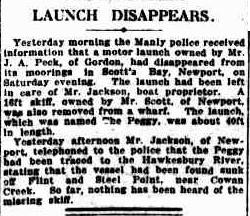December 18 - 24, 2011: Issue 37
Collin’s Retreat, Bay View House, Scott’s Sanatorium, Guest and Boarding House: Crystal Bay, Newport
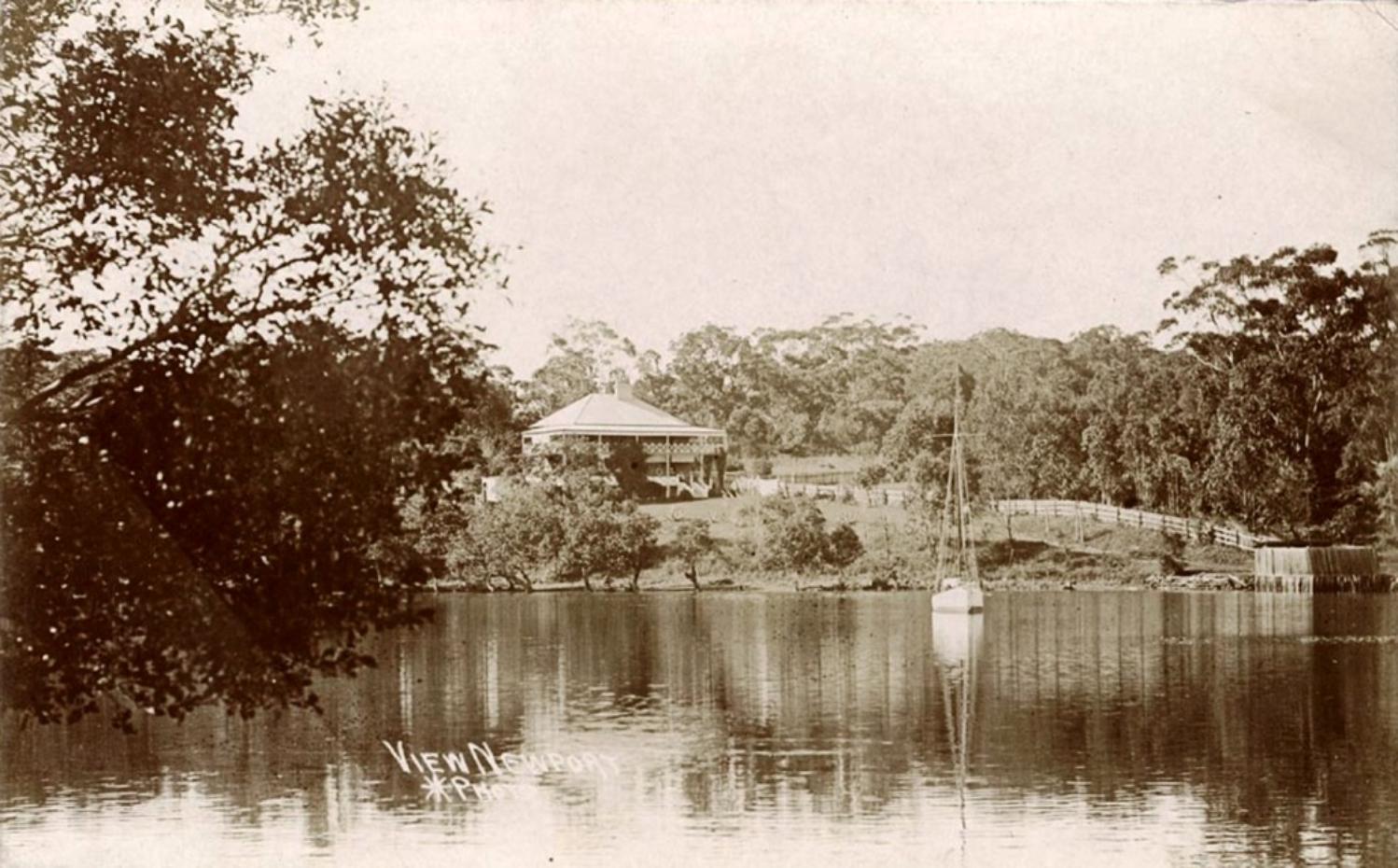
Scott's Hotel from Broadhurst image 1900-1927, Item: 106124h Courtesy State Library of NSW.
Overlooking Crystal Bay, and originally owned by Daniel Farrell, a member of the family who owned so much property in Newport, a lovely house that catered to visitors and sought to entice city dwellers to the ‘country’ was also a once famous meeting place for locals and VIP’s alike.
Named according to who owned it, and sometimes labelled to reflect the prayers of these people, a two storey house with around 25 acres of grounds, orchards, a dairy and even a rumoured still, offered excellent food and ‘superior accommodation’. Pittwater was touted as a ‘romantic spot’ during the 1870-1900s and attracted, amongst the farms and orchards that predominated Newport then, day trips for ‘excursionists’. The estuary allowed visitors to debark in calmer waters and they walked to the beach from there rather then the other way around as we have it nowadays. Steamers disgorged hundreds of visitors, some carrying up to 800 passengers. These weren’t just weekend forays into ‘The Pitt Water’, some came on Mondays, public Holidays, Thursdays or were hired to bring prospective land buyers to special one-off events of selling parcels of land with refreshments and a band as part of the occasion.
This shows it was being built or expanded in the Spring of 1882
The scene is rich with the luxuriant beauty of a New Zealand pass. Coming round the shoulder of the hill, openings in the trees betray glimpses of the deep blue waters of the lake, while the scene stretches away beyond to the high enclosing hills, in all their deep colouring, like one of Conrad Martens' pictures. A few minutes more, and the coach stops at the Newport Hotel, having accomplished the 14 miles in about two hours. At the waterside awaits the steamer Florrie. A little to the right, in a small bay, is another wharf, with a large house close by approaching completion, and destined for a boarding-house. The Sketcher. (1882, September 30). The Sydney Mail and New South Wales Advertiser (NSW : 1871 - 1912), , p. 542. Retrieved from http://nla.gov.au/nla.news-article161926095
In 1880 a man known as John Thomas Collins had leased the property from the Farrells and was host when the member for St Leonards visited;
ELECTORATE OF ST. LEONARDS. WILLIAM THOMAS MUSTON will address the Electors as under - St Leonards-Harding’s Hotel, Tuesday, 8 o'clock, North Willoughby-School of Arts, Wednesday, 8 o'clock. Manly-Bagnall's Hotel, Friday Evening, Pittwater-Newport and Collins', Monday Evening, Roll up and support an energetic Native, who has the time and ability to serac aou_milE ELECTORS OF ST'.LEONARDS. Advertising. (1882, November 27). The Sydney Morning Herald(NSW : 1842 - 1954), p. 4. Retrieved from http://nla.gov.au/nla.news-article13524504
METROPOLITAN QUARTER SESSIONS. THURSDAY.
The Metropolitan Quarter Sessions were resumed at Darlinghurst this morning, before Mr District Court Judge Murray
APPEAL CASE
John T Collins, of Newport near Pittwater, storekeeper, appealed against the decision of the licensing magistrates of the Water Police Court, under which he was fined the sum of £30 fir selling whisky on March 14 last, at which time he was not the holder of a publican's Licence. The grounds of appeal were that the appellant was not guilty of the offence with which he was charged, and that the evidence of the informer was not corroborated. Mr Tarloton, instructed by Mr W Roberts, sen., appeared in support of the appeal, and Mr Backhouse and Sub-Inspector Atwell appeared to show cause why it should not be allowed In a great measure the case was a rehearing, but some additional evidence was given Sub Inspector Attwell gave evidence to the effect that appellant’s premises presented the appearance of an hotel, and that he had found considerable quantities of liquor, together with many glasses, there Evidence was also called to prove that so far as a man named Walter Love was concerned liquor had been sold and paid for at the place. Appellant contended that it was untrue that any such sale had taken place, and called witnesses in support of his contention but it was admitted that he was in the habit of giving people liquor and not charging them for it. The Judge said that he did not intend to upset the decision of the magistrates because he believed, from the evidence now produced, that it was perfectly right. The place was a sly grog shop of a very common character. Those who lived in towns were not aware of the existence of such places, but those who travelled through the country know that they had been carried on for years In fact, there was a strong impression is the minds of some persons that the Act was an unfair one, and that they could sell liquor with impunity but the law was that such persons if they broke it, must be fined. He would uphold the decision of the magistrates, and would also allow £5 of costs for counsel against the appellant.
Sarah Ann Collins, wife of the above named appellant, appealed against a similar conviction against her The evidence was of the same character as that in the preceding case sub inspector Atwill deposed to having found liquor on the premises, and Walter Love proved that he had purchased a bottle of whisky from appellant the contention of appellant was that the whisky was obtained by Love under false pretences for another person who was a lodger, his conviction also was upheld, and costs were given against the appellant. METROPOLITAN QUARTER SESSIONS. (1883, June 15). The Sydney Morning Herald (NSW : 1842 - 1954), p. 3. Retrieved from http://nla.gov.au/nla.news-article13536960
The Farrells daughter Sarah was married to this man and they seemed keen to establish Newport as a holiday destination and ran a coach from Manly wharf to this house; Hawkesbury ' RIVER. Visitors wishing to see the beautiful scenery on the noted Hawkesbury, second to none in the world for scenery and beauty, can start from Sydney pier FRIDAY, 2 15 pm. steamer to Manly. Farrell's coach from Manly 3 15 to Newport, where passengers will find comfortable apartments for the night at Collins' Retreat. Advertising. (1883, December 19). The Sydney Morning Herald(NSW : 1842 - 1954), p. 2. Retrieved from http://nla.gov.au/nla.news-article13548655
 The Scott’s bought the property and 25-52 acres from Benjamin James in 1886. He had only recently purchased (1885) the house and 110 acres of land from Daniel Farrell around the time he was being labelled an ‘insolvent’ and disposing of various holdings:
The Scott’s bought the property and 25-52 acres from Benjamin James in 1886. He had only recently purchased (1885) the house and 110 acres of land from Daniel Farrell around the time he was being labelled an ‘insolvent’ and disposing of various holdings:
SECOND MEETING. Re Daniel Farrell, adjourned second meeting. One debt was proved. The insolvent was examined by Mr. Stephen, official assignee,' as to his expenditure during the six months prior to the date of the sequestration of his estate. From April to August Farrell lodged with his sister at Moore Park, but he did not pay her anything for board and lodging ; witness, about the end of 1885, leased a Jaree farm at Goulburn of Mr. F. L. Rossi, to whom he paid £800 a-year; witness then had property worth £5000 ; that property was sold through Hardie and Gorman to Mr. Benjamin James ; witness had spent the proceeds of the stylo; his bank account would show how he expounded the money; the property consisted of 110 acres of land at Pittwater, which witness sold to Benjamin James at £22 per acre ; INSOLVENCY COURT—FRIDAY. (1887, October 22). The Sydney Morning Herald (NSW : 1842 - 1954), p. 7. Retrieved from http://nla.gov.au/nla.news-article13677542
Early version of what is for sale:
NEWPORT. 300 acres, part cultivated, hotel, residence, water frontage, and wharf. Advertising (1886, February 24). Evening News (Sydney, NSW : 1869 - 1931), p. 8. Retrieved from http://nla.gov.au/nla.news-article111188750
This was later just 200 acres due to:
Benjamin James – 175 acres alongside Scott premises at Crystal Bay (and part of originally): Volume- Folio 1529-162 - 1933 - easement taken by WSC (Pittwater public land thoroughfares and Creeks series 2021-2026)
David Scott had previously worked as a portrait photographer and artist in the city. He and his family may have moved here in order to help an ill Dorcas Scott (nee Dickson), his wife, recover from an ongoing illness. They were married in 1860 with the marriage registered at Paddington:
SCOTT—DICKSON—November 28th, by special license, at the residence of the bride's father, by the Rev. James Adam, Mr. David Scott, of Sydney, to Dorcas, fourth daughter of Mr. Joseph Dickson, Waverley. Family Notices (1860, December 8). Sydney Mail (NSW : 1860 - 1871), p. 5. Retrieved from http://nla.gov.au/nla.news-article166695538
Dorcas Dickson was the daughter and child of Joseph Dickson and Mary Gee, born on November 28th 1839 in Sydney. David Scott was a son of John and Martha Scott, born about 1835 in England (possibly Camberwell). David Scott and his brother Ebenezer, came to Australia. Their parents, John and Martha Scott, resided in Camberwell, England, the hometown of the Dickson family.
Dorcas and David had six children. Two daughters died, one in infancy and the other at nine years of age, and David J Scott 1861 – 1926, Herbert Scott 1869 – 1934, Minnie Scott 1875 – 1956 and Leighton Scott 1879 – 1961.
He continued taking photographs, including local events such as cricket matches at Mona Vale into the 1900's. His speciality, according to him, past earlier portrait photography, was capturing scenes.
Mr. FREEMAN begs to announce the completion of some important alterations in his Studio, more especially in the distribution of light, thereby avoiding the glare so frequently a subject of complaint; and at the same time producing a more artistic and pleasing portrait.
Mr. FREEMAN invites particular attention to his INSTANTANEOUS process, for Children and Nervous Sitters.
Photographs enlarged and finished, in Oils, Water Colours, or Crayons.
B. WILLIAM BRADLEY having sold his business to his old and valued friend Mr. DAVID SCOTT, has great pleasure in recommending that gentleman to his numerous patrons, and respectfully begs to assure them that Mr. David Scott will be certain to produce portraits in all reflects equal to those taken by himself, as, in addition to his natural taste and long experience as an artistic photographer, Mr. Scott is in possession of the entire formula and processes used by Mr. Bradley with such great success. And, in addition to this, Mr. Scott has been thoroughly initiated into the exact method of operating practised by Mr. Bradley, and having now taken all the portraits at the above establishment for the last nine months. Many of these portraits being finer than anything that has hitherto been produced in Sydney, Mr. Bradley trusts that this may be taken as a guarantee of Mr. D. Scott's great ability. In conclusion, Mr. Bradley begs to thank his patrons for their favours, to kindly bestowed upon him for so many years past.
P.S.: The business will be carried on as usual under the same name of William Bradley, in order to avoid mistake.
London, November 12, 1869 Advertising (1870, January 29). The Sydney Morning Herald (NSW : 1842 - 1954), p. 2. Retrieved from http://nla.gov.au/nla.news-article13199690
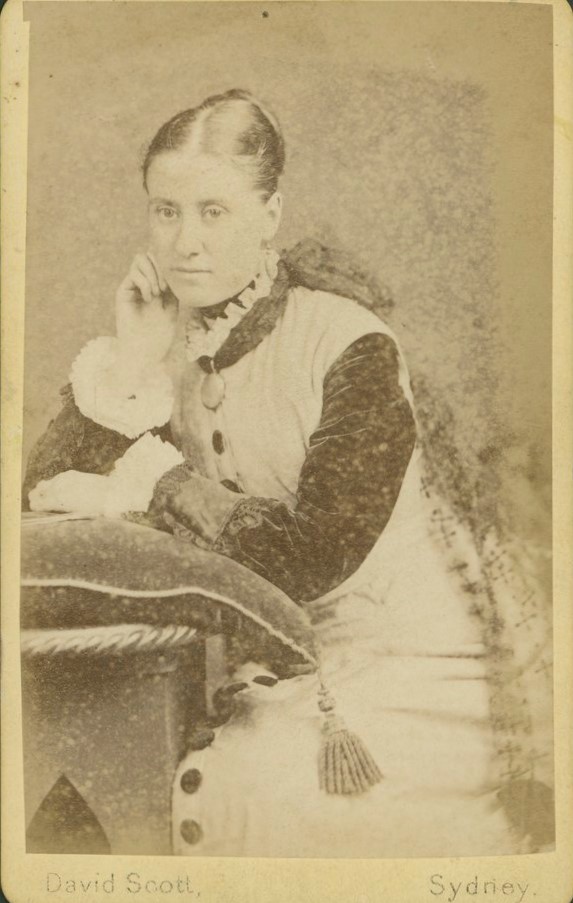

Portrait photographs by David Scott of Pitt Street, Sydney] [picture] / David Scott. Courtesy State Library of Victoria. and back of cards to show information there - first circa 1870.
TO THE EDITOR OF THE HERALD.
Sir,-In a report of the Fine Arts at the Exhibition, viz, photography, contained in this morning's Herald, terms of praise are attached to photographic portraits exhibited by a Mr. Montague Scott. I beg to state that it is an error, for if you will kindly refer to the Catalogue you will see that no photographs are exhibited by the above, The commendation was no doubt intended for me. As you will see by Catalogue, Class 495, No. 2536, that I exhibited both plain and coloured photographs, which have been highly commended by the judges, and as I have already suffered in my business through the mistake in the names, I will feel obliged if you will correct the mistake in your report to save me from suffering still further through it.
Your attention to the above will oblige yours, respectfully,
DAVID SCOTT.
140, Pitt-street, September 27th.
TO THE EDITOR, OF THE HERALD. (1870, September 28). The Sydney Morning Herald (NSW : 1842 - 1954), p. 3. Retrieved from http://nla.gov.au/nla.news-article13222066
BUIST and SON.-Pianofortes, harmoniums, concertinas, &c, tuned and repaired. 235, George-st. ESTABLISHED 30 years.
PHOTOGRAPHY.-DAVID SCOTT (successor to William Bradley), Artist Photographer, 140, Pitt street, Sydney. Awarded Prize Medal. Advertising (1872, July 22). The Sydney Morning Herald (NSW : 1842 - 1954), p. 1. Retrieved from http://nla.gov.au/nla.news-article13260819
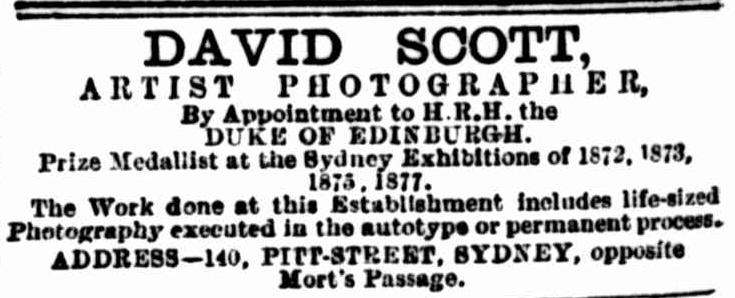
(1878, October 26). Australian Town and Country Journal (Sydney, NSW : 1870 - 1907), p. 8. Retrieved from http://nla.gov.au/nla.news-page5668734
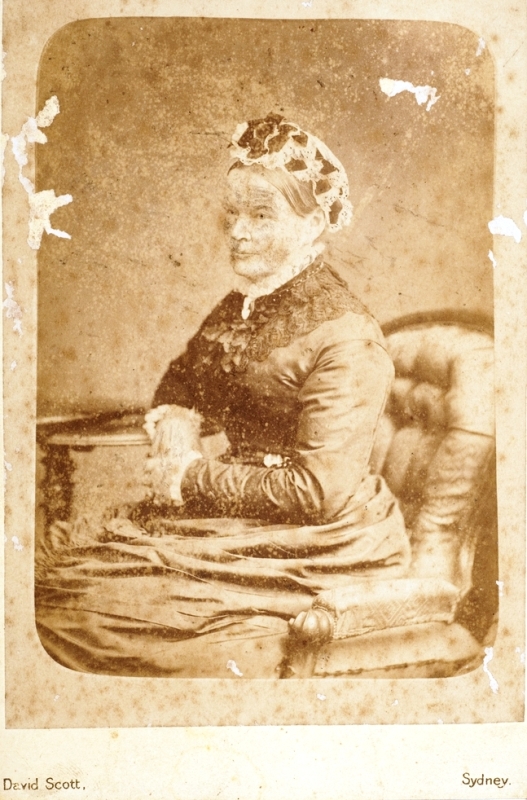
Louisa Ewer, ca. 1871-1879 by photographer David Scott. Image no a4215042h, courtesy State Library of NSW.
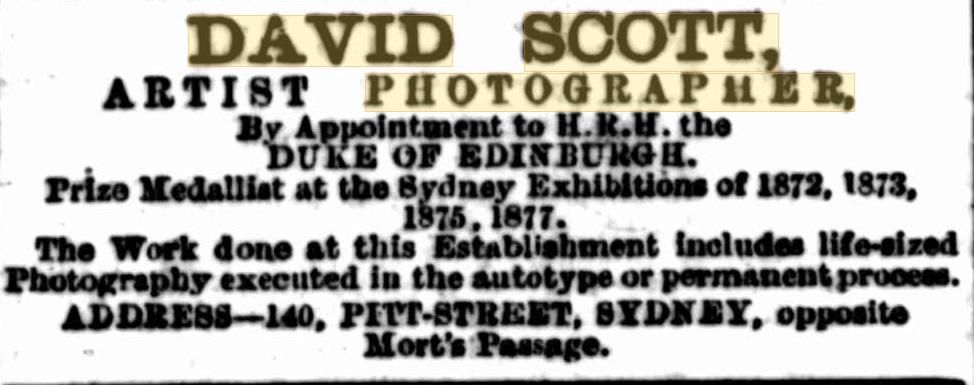
Advertising (1879, January 18). Australian Town and Country Journal (Sydney, NSW : 1870 - 1907), p. 42. Retrieved from http://nla.gov.au/nla.news-article70934466
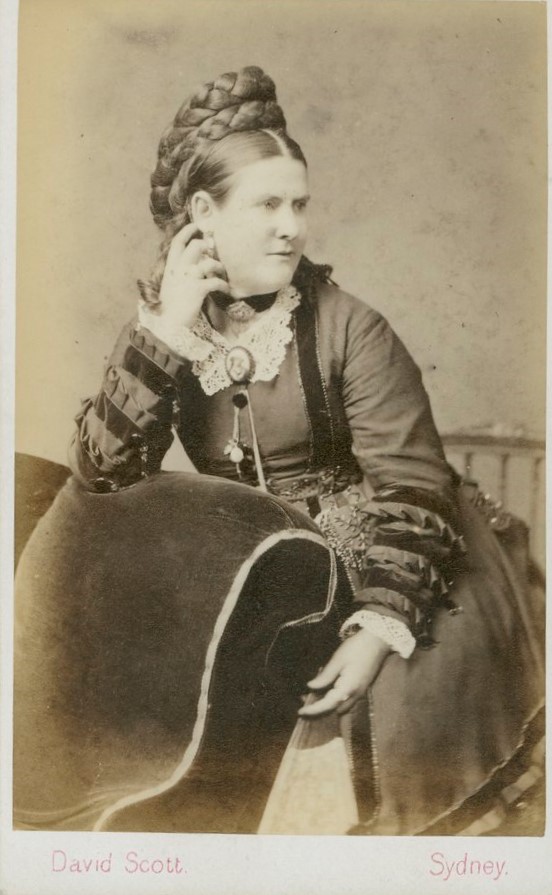
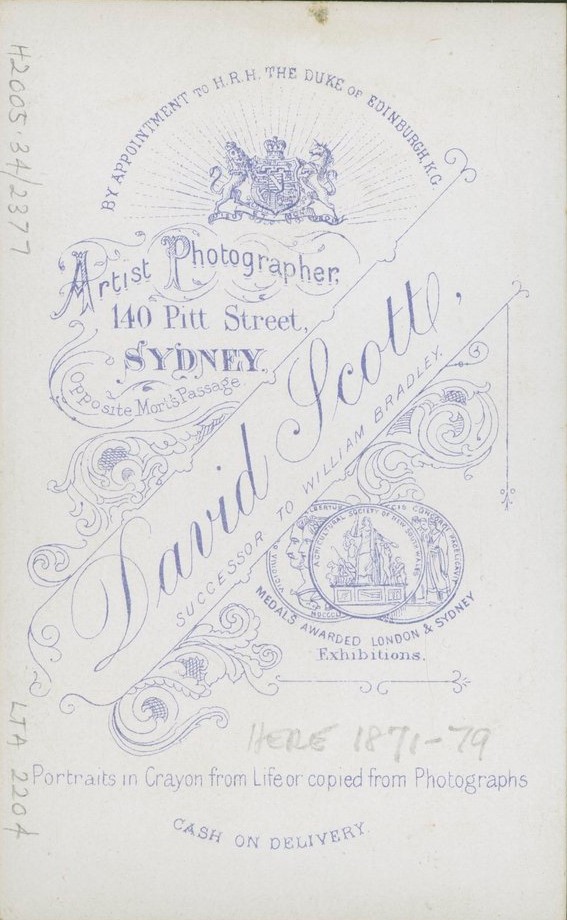
Portrait photographs by David Scott of Pitt Street, Sydney] [picture] / David Scott, 1857-1885. Courtesy State Library of Victoria. and back of cards to show information there - first circa 1870-1880.
Sketches at the Camp.
BY means of the instantaneous photography process, worked out by Mr. David Scott, photographer, 416, George-street, Sydney, to whom we are indebted for the sketches, our artist has been able to reproduce several pictures taken during the camp evolutions at Windsor. Of the proceedings he says :
On reaching Windsor by train about 11 a.m., at which hour the cool atmosphere is so refreshing, for which Windsor is so famous, I strolled down to South Creek, where willows line its banks, and under the shade of which the engineers under the direction of Captain Parrott constructed a pontoon bridge which spanned South Creek. The bridge was made of casks and miscellaneous timber, the whole structure being of sufficient strength to carry men and stores (as in engraving). I believe the bridge was never tested for carrying a load, but came in as practice for the engineers.
During the morning (after parade), an arrangement having been made for an attack upon and defence of the camp, the attacking party, under the direction of the commandant, marched for open ground the defence force under the command of Lieut.-Colonel Wilkinson being left in the camp, and piquets shortly stationed for its defence, some of which took shelter in one of the trenches (see engraving) -which had been thrown up by tho engineers. Shortly afterwards guns were heard in tho direction of the railway. The defending party at once brought their guns into position to bear on the spot where the enemy had been discovered. As the attacking party, advanced steadily over the hill towards the camp rifle and gun shots were exchanged, becoming pretty lively, as may be seen detailed in the engravings. The right flank of the attacking party, bore on the left flank of the defending party the effort being made with strong force, but which was met by the two guns in camp. The artillery fire of the camp held the enemy in chock for a few moments, but they were overwhelmed by the enemy's infantry, and the invaders gained the day. The bugle was then sounded for mustering, and, after general salute, the troops dispersed to their different quarters for dinner and for cleaning arms.
Another sketch shows some of the engineers at dinner, the centre gentleman doing the amiable to the loaf of bread, powder seeming to sharpen the appetite, if we may judge from the smiling expression on the different countenances. After packing up traps and departing for home by the evening train, an elderly lady beguiled us on our way by a lecture on the noise of those horrid guns, during which I fell asleep, which ended for the time being all remembrances of the Easter camp.
The location of the mimic battlefields of Windsor is certainly among the most charming of situations for the purposes of an encampment. The pictures descriptive of the sham fights are exceedingly : characteristic, and show our citizen soldiers at their best. The sham battles by day were exceedingly well conducted, and were witnessed by many thousands of spectators in weather that was simply beautiful, so that the enjoyment was thorough, throughout, both on the part of our citizen soldiers and on the part of the visitors who flocked in large numbers from Sydney, Windsor, and Richmond to witness the manouvres. The night attack on tho camp, the feint being made from the railway, and the real attack from tho rear of tho camp, was perhaps one of tho best episodes yet witnessed in the colonies in connection with volunteer work, and reflected high, credit on all concerned. Ab the dinner given to Ministers on the ground by the staff officers, the Premier expressed himself in the highest terms of praise at what he had witnessed, and Sir Edward Strickland, K.C.M.GK, stated that in his opinion our volunteers were among the finest in the world. The Colonel-Commandant from Tasmania and Commodore Erskine, of H.M.S. Nelson, spoke to the same effect ; and generally speaking there can be no doubt that the late Easter Encampment was the most successful that has ever been held in New South Wales. Sketches at the Camp. (1884, April 26). Australian Town and Country Journal (Sydney, NSW : 1870 - 1907), p. 19. Retrieved from http://nla.gov.au/nla.news-article71011048
During the first two years of his proprietorship he kept the name ‘Bay View House’ in all advertisements but advertised the property, and its ‘curative’ aspects as ‘Scott’s Sanatorium’ in the years 1891-1892. This may have been an appeal to the advert readers but also may denote his wish that his wife be cured. He also seemed to be in charge of renting another, smaller cottage.
TO CAMPING PARTIES.-To LET, at Newport, Pittwater, a two-roomed COTTAGE, plainly furnished, rent £1 per week. Apply D. SCOTT, Newport, Pittwater. Advertising. (1888, January 14). The Sydney Morning Herald(NSW : 1842 - 1954), p. 21. Retrieved from http://nla.gov.au/nla.news-article13675912
NEWPORT, Pittwater, a Lovely Place, the Saratoga of Australia.-Superior Accommodation. D. Scott, Newport Advertising. (1888, January 30). The Sydney Morning Herald(NSW : 1842 - 1954), p. 3. Retrieved from http://nla.gov.au/nla.news-article13677690
Advertising. The Sydney Morning Herald (NSW : 1842 - 1954) Saturday 16 November 1889 p 20 Advertising ... spot.

Scotts Newport circa 1900, Item: FL11283178, Courtesy NSW State Records and Archives

Scotts Newport circa 1900, Item: FL11281536, Courtesy NSW State Records and Archives
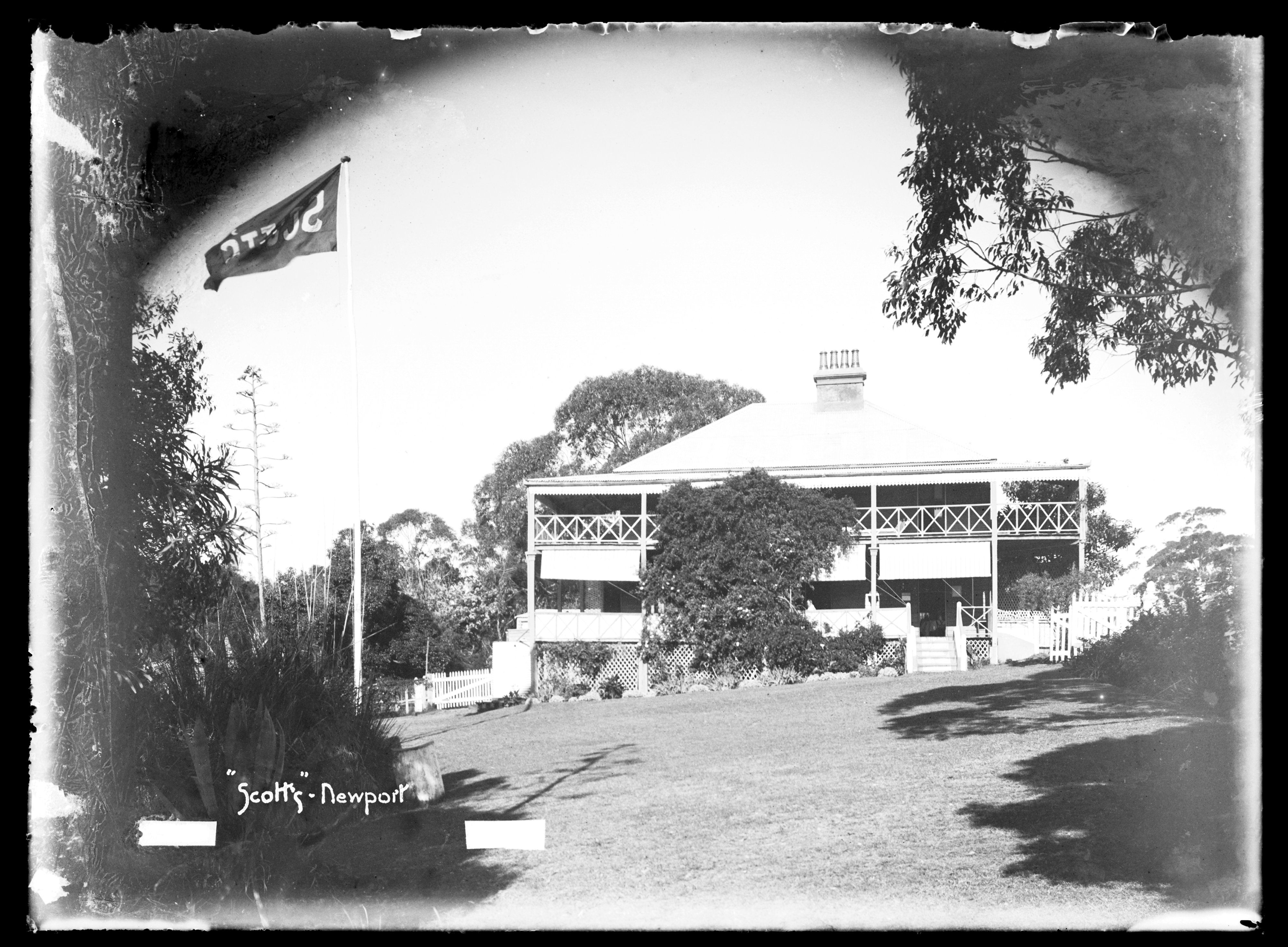
Above: Scott's' guest house at Newport (NSW) circa 31/12/1908 Pic No 18526_a024_000031, Below: Tables at Scott's Guest House, Newport (NSW) Pic No: 18526_a024_000106 Below This: View from Scotts Guest House at Newport PIc No: 18526_a024_000098, Under This; View towards Bayview from Scott's guest house at Newport Pic No: 18526_a024_000053 All dated 31/12/1908 and from the State Records of NSW
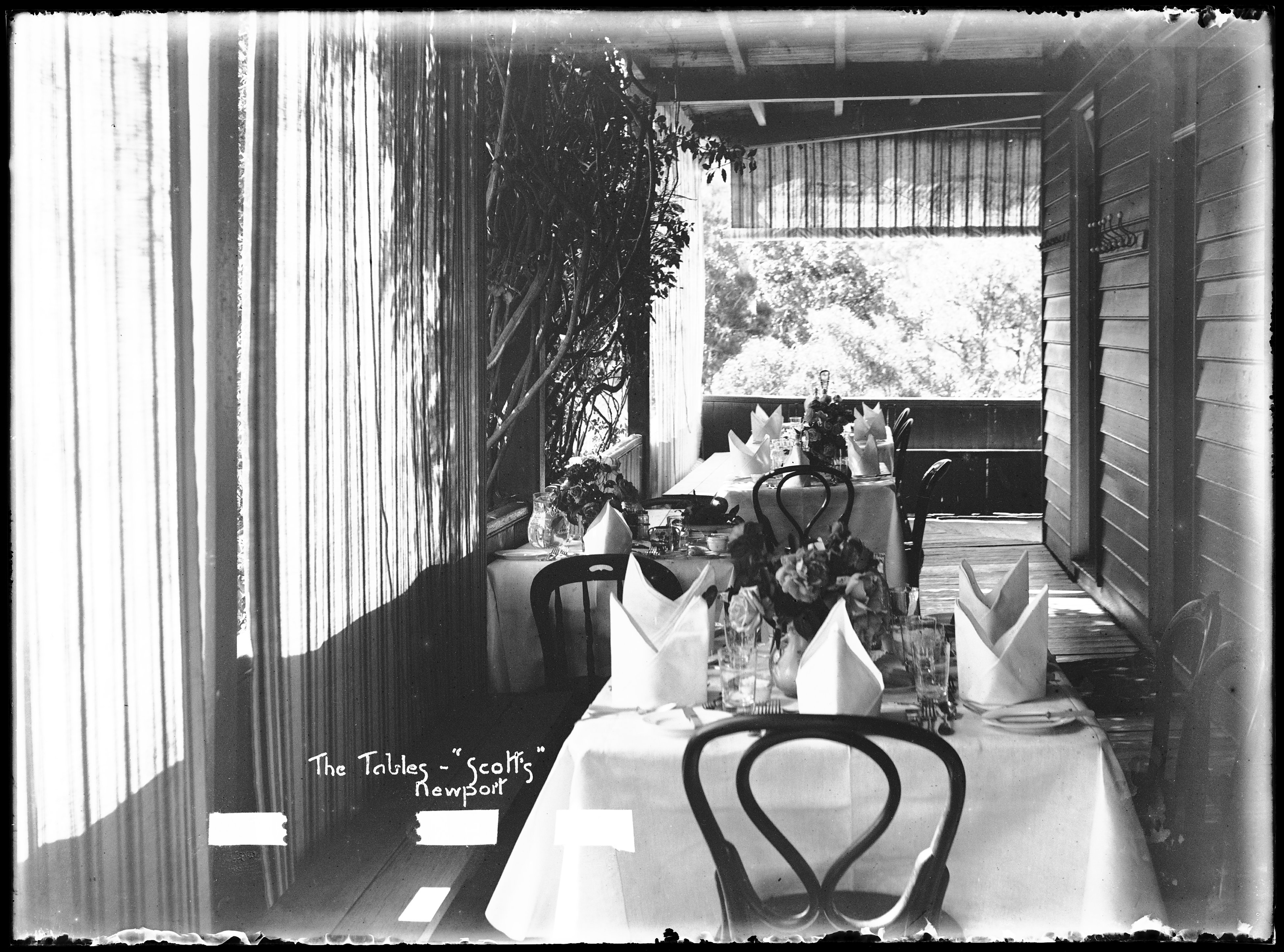
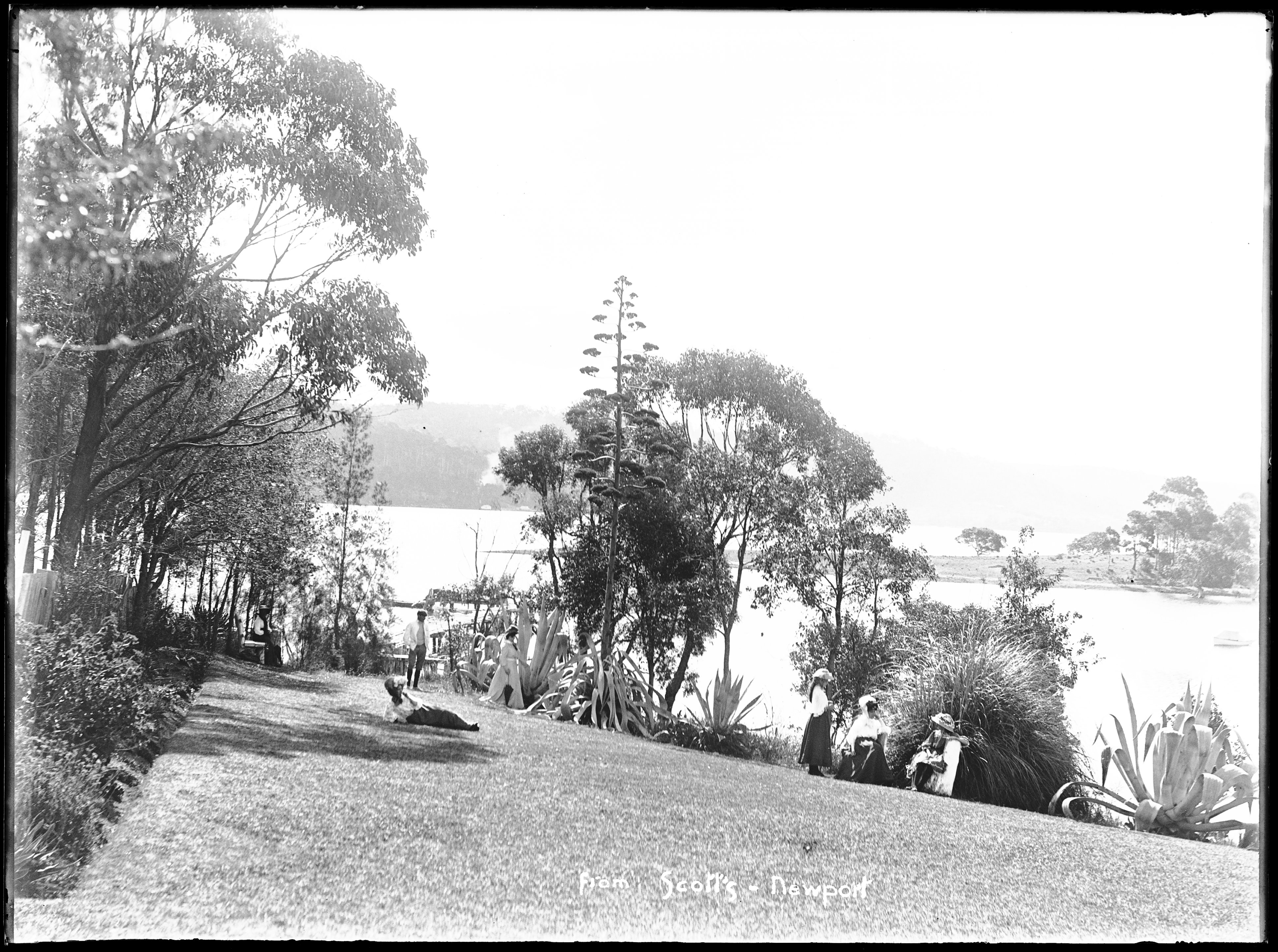
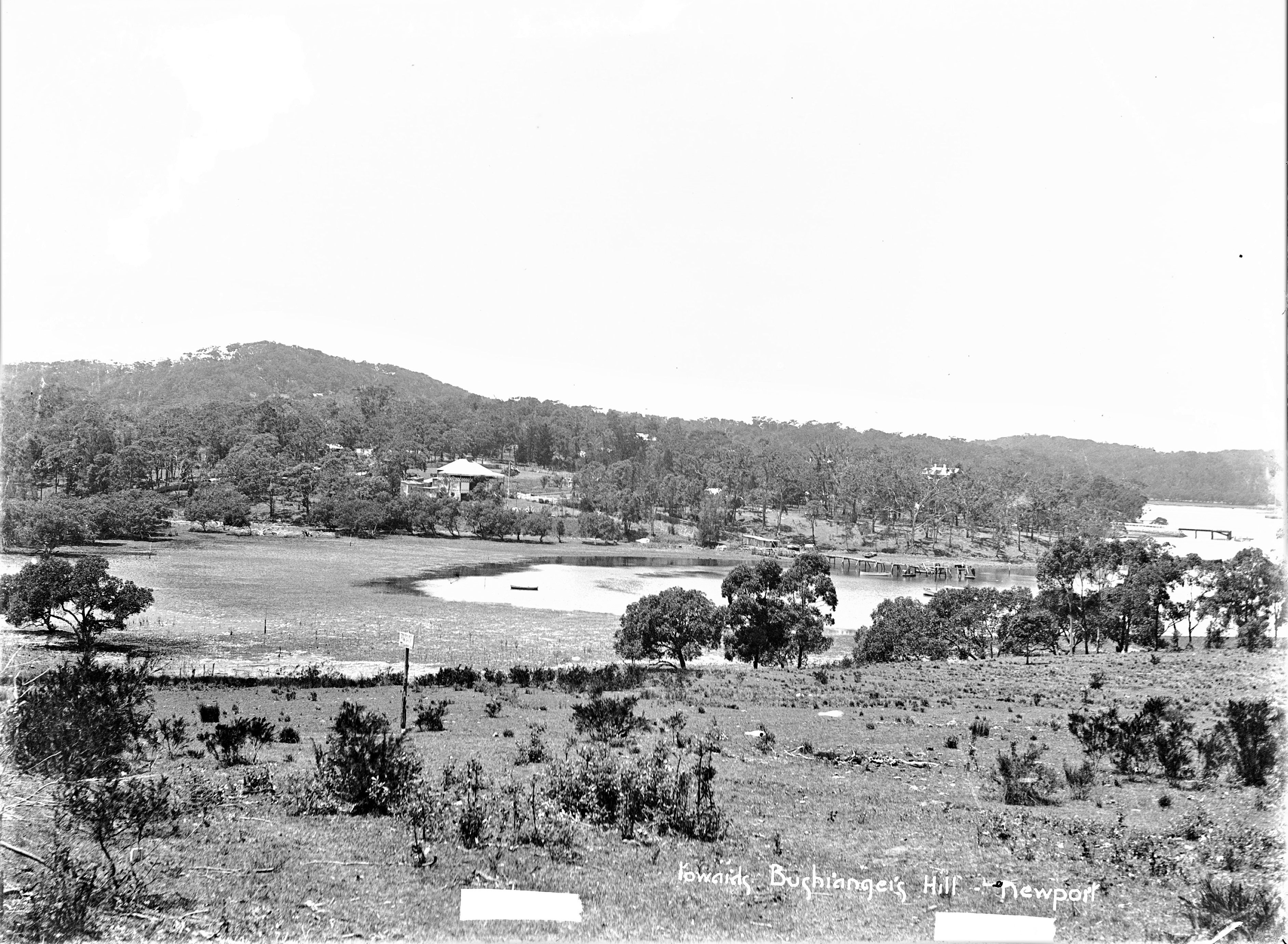
-Superior ACCOMMODATION, Bay View House, salt water swimming bath, boats, &c. D. D. SCOTT
SCOTT'S SANATORIUM, Newport, Pittwater.
Delightful place" ; the place for a day or a month. All Particulars BULLARD and CO., George-street, city. Advertising. (1891, August 22). The Sydney Morning Herald(NSW : 1842 - 1954), p. 2. Retrieved from http://nla.gov.au/nla.news-article13835936
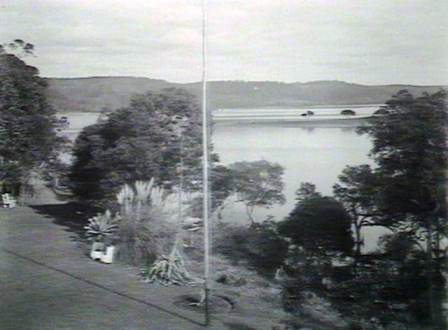 From a Family History:
From a Family History:
When Royal Sydney Yacht Squadron raced from Sydney Harbour to The Basin, Pittwater, owners and crew celebrated at Scott's Hotel. Club members and friends would drive up early to await the yachts. It was all sailing, shanties and slops until early morning. This was the beginning of early yachting. As the numbers grew, and with an already famous hotel, David Scott started Scott's Boatshed in about 1912.
Steamboats "Nammoye" and "Gwyder" ran from Circular Quay to Newport. Scott's Hotel supplied music, liquor and food. Everything was running smoothly until Millers Point Push arrived attempting to take over. With each visit they grew coarse and louder. Brawls broke out: Knuckle dusters, cosh, objects wrapped in newspaper, even hardwood fence pickets were found scattered about when they left.
David Scott went to town to hire a bouncer (Black Brooks). The following Saturday morning he arrived clean and well dressed. One gentleman described him as being "the biggest, strongest looking American Negro you ever laid eyes on". Apparently standing head and shoulders above the average Australian. He openly challenged Push Leaders, as David watched approvingly, louts and larrikins cheered them on. The American proved to be a great street fighter with no holds barred. Push members returned each week with a new tough champion. They soon learned to walk around David Scott's one and only bouncer.
With no Law abiding citizens to jostle, the undesirable types eventually moved on. This account of the last stand from the "Push" comes from Guy Jennings, The Newport Story 1788-1988, 1987.
Thomas Hodges, an ex-policeman and manager of the Newport Hotel, hired an American boxer (Jack Castlemaine) as bouncer. On Sunday February 14 1892, the usual load of larrikins arrived. they raided Scott's orchard and sent rocks through the windows. When the mob moved to the pub and started breaking glasses, Thomas Hodges and Jack Castlemaine called for order - they were laughed at. Big Jim and Black Brooks moved in from the rear wielding large chunks of four-by-two. The gangs beat a hasty retreat to the wharf. Once safely on board the larrikins vowed to return for their revenge the following Sunday.
The following Sunday the weather was not good. A southerly blew up making for a rough passage. The sea sick louts were met on the wharf by the four bouncers, stripped to the waist, big clubs at the ready. A few of the toughest came ashore, but were no match for the boxers hired as bouncers. The gangs were not seen again and family picnics became the order of the day. A few years later the bouncer failed to return for the opening of the new summer season.
The hotel was a big boarding or guest house, and soon became a show place. A herd of milk cows supplied all dairy products: some red meat, pigs, poultry and pigeons were kept in large numbers. Any game bird could be ordered and local fish was a speciality. The vegetable garden and orchard also supplied the enormous kitchen. Scott's Hotel, Newport, was a culinary delight, well patronized by those who could afford such luxuries. Their motto "the best table and service north of Manly".
The cellar provided wines and spirits which had no equal on the northside. It was locally said that they brewed some of their own - a common practice in those times. Others claimed that a still existed behind the cow paddock and creek, where a strong palatable spirit was made and approved of by local judges using the "tongue and lip" method.
Horses were bred in the cow paddock, others out on agistments. On maturing they were sold to local coachmen. The horse-drawn coach from Narrabeen terminated at the hotel in Princess Street.
A cactus hedge was planted to the waters edge. Flame and pine trees were scattered about. Level green lawns like billiard tables were everywhere. Croquet court and the grounds were kept spotless, so were the staff. Tremendous parties were organised for well known families, business houses and clubs. Chinese lanterns, fairy lights, bunting and streamers decorated the grounds. An orchestra played in the garden, beautifully gowned women danced with partners in white tie and tails. Honeymooners and holiday makers came from all over New South Wales. Many garden seats faced the water view. As the seats could not be seen from the Hotel, these lovers seats gave privacy. Scott's Boarding House and Crystal Bay, 1925. From; http://dicksonvearingcrawford.com/Dorcas_Dickson_1839-1892.html

Advertising (1891, December 21). The Daily Telegraph (Sydney, NSW : 1883 - 1930), p. 2. Retrieved from http://nla.gov.au/nla.news-article235935132
After Dorcas’ passing from cancer in 1892, David Scott has another managing the premises:
SCOTT.-April 19, at her residence, Newport, Pittwater, Dorcas, the beloved wife of David Scott, aged 52 years. Family Notices. (1892, April 20). The Sydney Morning Herald(NSW : 1842 - 1954), p. 1. Retrieved from http://nla.gov.au/nla.news-article13861711

Advertising (1892, December 31). Australian Town and Country Journal (Sydney, NSW : 1870 - 1907), p. 45. Retrieved from http://nla.gov.au/nla.news-article71208194
David Scott was among those wanting to see Newport ‘Go ahead’ as a developing area and spoke at a meeting at Newport Hotel in favour of a railway link to Newport, not only because it would bring more visitors but also encourage more residents;
Mr David Scott said he felt convinced that a line of railway from North Shore to Pittwater would yield as good a return as any line in the colony, for the cost of construction and working would be very small, whilst the passenger traffic would be very large from the crowds of visitors to the district at holiday time he had often heard expressions of wonder at a place so beautiful and attractive being so little known, and so ill provided with means of communication with the metropolis
AND; He said four years ago he formed a high opinion of the prospects of the Pittwater district and despite the lapse years that opinion had been strengthened and confirmed. It was part of his business to discover the beauty spots of the colony but he had not yet come across a place that could compare with Newport in the matter of natural beauties and attractions there were thousands of visitors to the district, and although this was a matter of congratulation it was residents rather than visitors that were wanted… RAILWAY MEETING AT NEWPORT. (1890, June 23). The Sydney Morning Herald (NSW : 1842 - 1954), p. 3. Retrieved from http://nla.gov.au/nla.news-article13799804

Above: Last: Walking towards Newport Beach Pic No: 18526_a024_000069, dated 31/12/1908 and from the State Records of NSW
Minnie and Leighton were both named as the first children to enrol at Newport Public School when that opened in May of 1888.
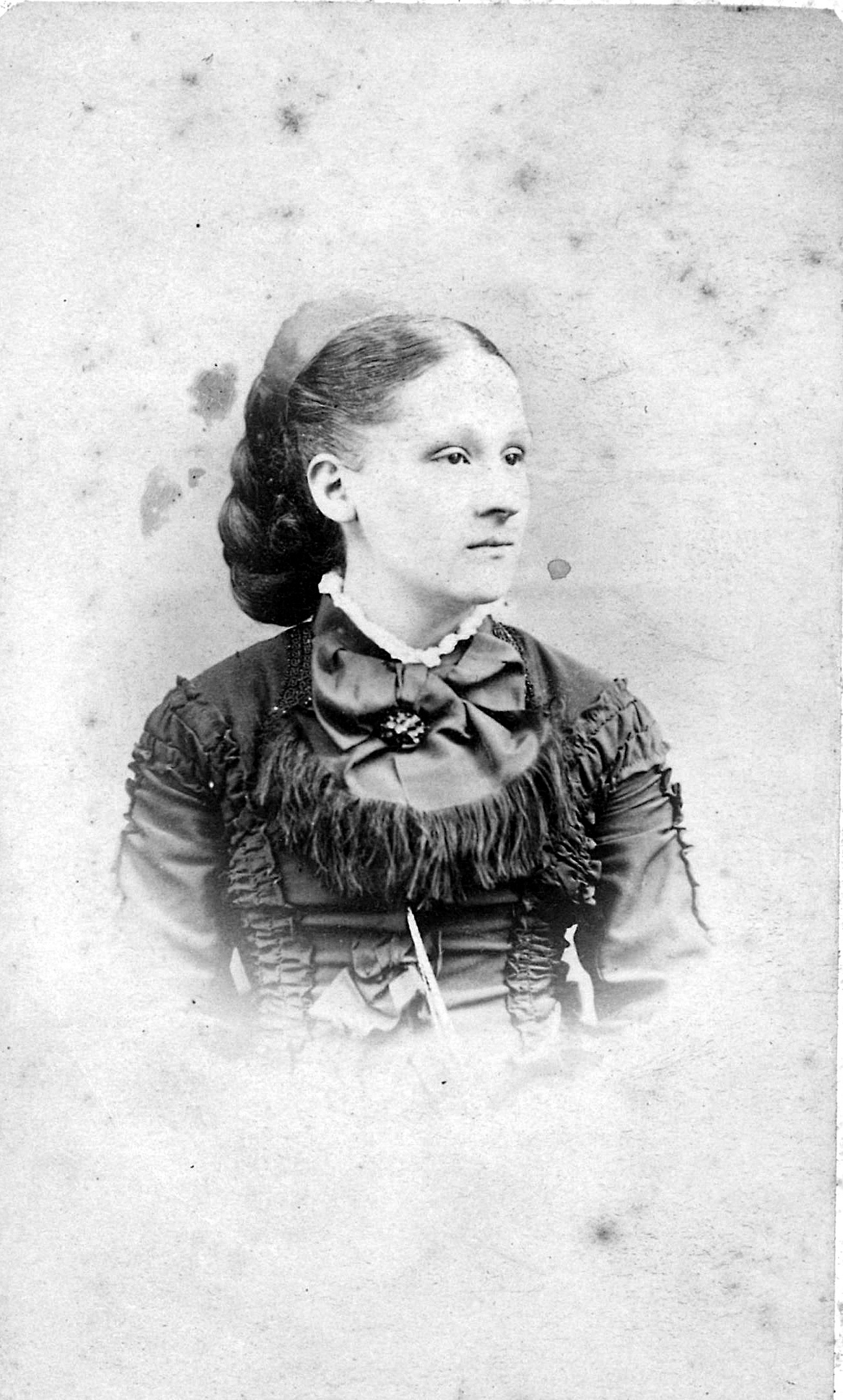
Minnie Scott
After 1892 the business flourished under then 18 year old daughter Minnie Scott.:
Minnie Scott, keeper of a boarding-house at Newport, wished to correct evidence she had given. She had not had this place for 18 years, but only since she was 18 years of age. She gave evidence respecting the dates Mr. J. B. Dalley had visited her house and the dates Mrs. Dalley had been there. DIVORCE COURT. (1905, November 23). The Sydney Morning Herald (NSW : 1842 - 1954), p. 4. Retrieved from http://nla.gov.au/nla.news-article14741607
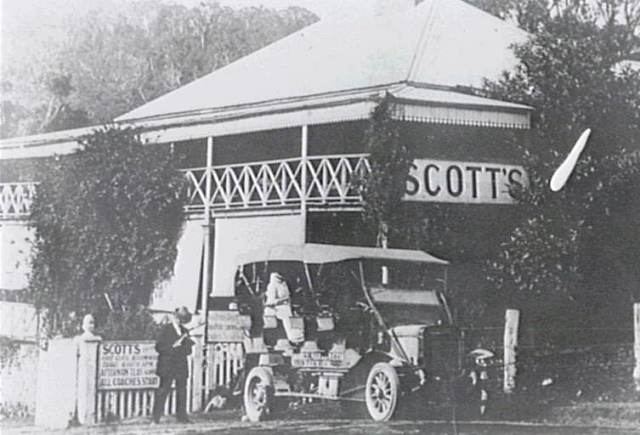 It’s reputation rose under her stewardship, despite those who used the premises for alleged illicit purposes, and became a place for honeymooners, community celebrations and was famous for its ‘fish dinners’. By 1896 the mortgage on the premises had been discharged and the business thrived as a place for honeymooners or more exclusive parties. Steamers landed people at their own jetty on Crystal Bay and it was one of the places to be on New Year's Eve.
It’s reputation rose under her stewardship, despite those who used the premises for alleged illicit purposes, and became a place for honeymooners, community celebrations and was famous for its ‘fish dinners’. By 1896 the mortgage on the premises had been discharged and the business thrived as a place for honeymooners or more exclusive parties. Steamers landed people at their own jetty on Crystal Bay and it was one of the places to be on New Year's Eve.
This description sounds a little alike the cottage available for rent at Scott's, although it could have been Lovett's Bay too:
PITTWATER.
I will write and tell you about a delightful holiday Flo and I had a few weeks ago. We had grown rather tired of the Mountains, and thought a seaside place would be a change, so at last we decided on Pitt-water. We started one Friday afternoon, and, catching the 3 o'clock boat to Manly, reached it in plenty of time for the Pittwater coach, which left Manly shortly after 4 o'clock, and arrived at Pittwater in time for dinner.
Although we had a 12 miles' drive by coach, still we did not find it a tiresome one, for the road was good all the way ; besides, the scenery was so beautiful. All along the route there was something interesting to look at.
Now we were passing through a forest of tall trees and beautiful cabbage-tree palms, and wild flowers growing in great profusion ; and then suddenly we were confronted in all its grandeur by the ocean itself. And so on we drove, until Church Point, which is as far as the coach goes, was reached, and we found ourselves on the shores of Pittwater.
We had made arrangements beforehand as to what coach we would come down by, so we weren't surprised on leaving the coach to find a small motor launch waiting to convey us to our destination.
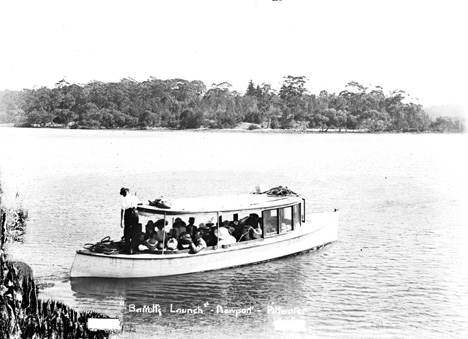
Above: Barretts' launch at Newport, Dated: c. 31/12/1908, Digital ID: 18526_a024_000028, courtesy State Records of NSW
After about 10 minutes in the launch we entered a pretty little bay surrounded almost by mountains, and picturesquely situated on the side of one of these was the cottage which was to be our abode for the next ten days.
Next morning we awoke early and made a tour of inspection, and were delighted with the place, for, besides having a nice orchards, cows, poultry, plenty of milk, eggs, cream, and oysters, we discovered a bathing-place securely fenced off and boats if we cared to fish or row.
After break-fast the little launch in which we had come across in the previous evening, and which belonged to the house, was waiting at the pier to take us to see some of the beauty spots round about. That morning we went up as far as the Barrenjoey Heads, which are the entrance to it from the ocean side. On the South Head is the famous Barrenjoey lighthouse. Then we went round Lion Island into Brisbane Water, on to the mouth of the Hawkesbury River, and on our way back landed at Barrenjoey to inspect the light-house, and thence homewards, after having spent a most enjoyable day.
Next day we went in quite an opposite direction, and soon found ourselves in the Kuring-gai Chase. Leaving the launch, we followed the path up the mountain. At first we anticipated rather a dreadful climb, but soon the beauty of the flowers and ferns attracted our attention, and so onward we pressed until the summit was reached. Sitting down, we gazed on the surrounding scene — one of the most glorious I had ever looked upon. Down beneath us was the water sparkling like diamonds in the Summer sunshine, and jutting out into it a large isthmus richly clothed in all its beautiful verdure and foliage ; whilst studded here and there among the trees were tiny cottages. Then further on Church Point, and Scotland Island appear-ed ; and still further on Bayview and Newport. And so our days were spent exploring new places, picnicking, and fishing, until at last the morning came for our departure homewards. And it was rather unwillingly that we bade farewell to beautiful Pittwater. Our board, which was very good, indeed, cost us 30s a week; and as there were two of us, and we stayed ten days, it came to £4 6s, a slight reduction being made for staying over the week. The coach journey cost 6s return for the two or us, and out fares by tram and ferry Is each, making in all £4 14s. This covered everything excepting tips, but as everyone has his or her idea on that subject I thought it best to leave that item out.— CONSTANCE (Enmore). PITTWATER. (1906, December 23). Sunday Times (Sydney, NSW : 1895 - 1930), p. 4 (The Sunday Times Magazine Section). Retrieved from http://nla.gov.au/nla.news-article126553173
NEWPORT LIFESAVING CLUB
Some members of the North Steyne Life-saving Club, under Captain Merritt, visited Newport, and gave a demonstration on the beach in land drill and rescue work to the entertainment of a good number of spectators. After the exhibition the party adjourned to a banquet at Scotts Hotel, where they were received by the president, Mr Trevor Jones and Councillors Quirk and Pommell who made reference to good work performed by the North Steyne Club. NEWPORT LIFE-SAVING CLUB. (1910, February 18). The Sydney Morning Herald (NSW : 1842 - 1954), p. 12. Retrieved from http://nla.gov.au/nla.news-article15150562
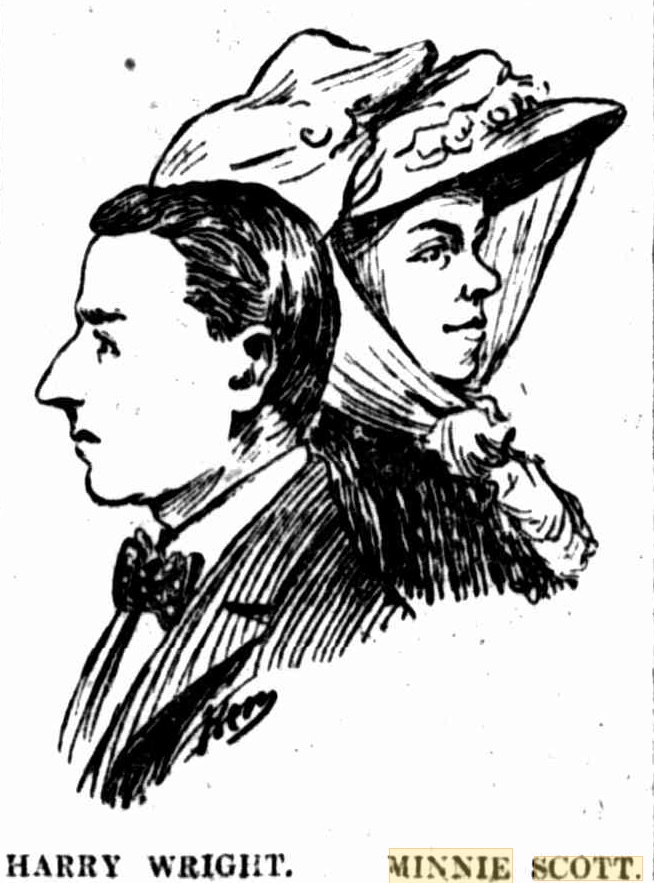
David Scott passed away in 1913, the death was registered at Manly:
SCOTT.— February 15, 1913, at his residence, Newport, David Scott, aged 78 years. Family Notices (1913, February 17). The Daily Telegraph (Sydney, NSW : 1883 - 1930), p. 6. Retrieved from http://nla.gov.au/nla.news-article238627286
An old identity was lost to the Pittwater district by the death of. Mr. David Scott, of Newport, whoso remains were interred at Waverley Cemetery on Monday. Mr. Scott, who had formerly carried on .business as a photographer in Sydney, went with his wife and family to reside at Newport nearly 30 years ago, and purchasing a house situated on the Isthmus that divides Pittwater from the ocean, opened a boarding-house, which for a quarter of a century has been visited by cyclists and other travellers going north from Manly. PERSONAL. (1913, February 22). The Daily Telegraph (Sydney, NSW : 1883 - 1930), p. 12. Retrieved from http://nla.gov.au/nla.news-article238617462
Over time, increased settlement in the area required greater variety of goods, foodstuffs and building materials. Leighton "Lee" Scott built a slipway to repair his boats, doing private work in between times. Later he added a large shed. A large sign outside read "Scott's Boat Shed". A passenger service was started and he then successfully contracted to carry school children to Newport from around Pittwater.
Lee was tall, tanned, a fine athlete and great sailor a who could handle any boat in the foulest of weather. All and sundry wanted him for their crew. Peter McNanamey (1981) "as a rower he was superb, in any kind of boat, out in front no one could catch him. Many wagers were placed on privately arranged races in various crafts, all were thought up in the hotel. If late off the mark Lee often withdrew, some said he lacked the professional or killer instinct".
Bert Payne (1981) an old time member of Newport Surf Life Saving Club, "Lee was a strong swimmer with a fine physique. First Club Captain, banner carrier for the club's march past team before World War I".
Lee acted as companion bodyguard for a "millionaire" connected with C.S.R. One of Lee's duties was to have him in good shape to attend meetings, charity balls, theatre first nights, parties galore. Lee accompanied the gentleman everywhere, often decked out in tails himself.
Many men who knew him said "no need for him to get married, he gets plenty of everything". However he apparently did get married "to the prettiest girl in Newport Beach". Although her home was Manly. Initially they stayed at the hotel, then moved to a house in Princess Street. The marriage was said to be doomed before it even started. Lee lived in the cottage claiming that it was unlucky for him.
It was sold in the 1930's to a French national, who shot himself when France was occupied by Germany in 1939.
Scott's Hotel had it's peak from 1918-1930, during which time it specialised in fish meals. The 1930 depression adversely affected the Hotel. Bert worked for Clifford Love and Company, he and his wife took over from Minnie, stayed a couple of years then left. The Kemp family were the next managers. World War II changed everything. A Mr McClintock lived permanently at Scott's Hotel.
Mr Douglas rented a section not in use for residence. Soon after the property was demolished as further development in the area took place. Perhaps the last advertisement;
SCOTTS HOTEL Newport Xmas and New Year Accommodation Vacant for a limited number of guests Mona Vale 41 for particulars. Advertising. (1932, December 7). The Sydney Morning Herald(NSW : 1842 - 1954), p. 4. Retrieved from http://nla.gov.au/nla.news-article16935781
Lee boasted that he never paid rates, every now and then the Council would auction off a section of the land for back rates. Mr McClintock purchased the last large block about 1945-46.
Hedwig Rainaud, of Bayview, Catherine Sussanah Lloyd, of Bayview, and the estate of Michael O'Callaglian; overdue rates, £29 2s. 4d.; land, lot 12, d.p. 11,518, Corniche-road, Bayview.Dorcas Scott and David Scott, both of Newport, Herbert Scott, of North Sydney, George Watkins Phillips, of Sydney, and Minnie Scott, of Collaroy; overdue rates, £427 Is. Id.; land, part portion 37, Prince-street, Newport.Arthur Jabez Small, of Sydney, Avalon Beach Estates Limited and Louise Augusta Alrich, of Mosman; overdue rates, £116 18s. 4d.; land, lot 115, d.p. 16,393, The Serpentine, Avalon Beach.OVERDUE RATES.—SHIRE OF WARRINGAH.—Land to be Sold (1943, June 25). Government Gazette of the State of New South Wales (Sydney, NSW : 1901 - 2001), p. 1098. Retrieved from http://nla.gov.au/nla.news-article222037688This last block was sub-divided and sold in the 1950's, making a very handsome profit.
Minnie died at her Princess Street home October 18th 1953, aged 82. Joan R, Lee's secretary, had been running the business successfully for years.
After Minnie's death, Joan and Lee purchased "Brae Cottage" (in separate names), Princess Street, from an old friend Peter McNanamey. McNanamey bought Scott's boat shed.
At last Lee was looked after by someone who was kind and nice to him. As the years passed, he wandered about not caring about his dress or habits. Locals described him as " A wealthy eccentric, lived here for years". "St Joan" waited on him hand and foot, the last 12 months being terribly trying.
Leighton Scott died November 7th 1961 aged 82. Joan made all the arrangements. Neighbours could not console the fine healthy woman, who passed away within a year. "she loved Lee so much, died of a broken heart and malnutrition".
From Scott's Boarding House and Crystal Bay, 1925. From; http://dicksonvearingcrawford.com/Dorcas_Dickson_1839-1892.html

Above: Scotts Hotel Sign: Sunday 5th of February 1911, Top of Newport Hill and corner of Beaconsfield streets and Barrenjoey road, from Album 56: Photographs of the Allen family, 1 December - 30 April 1911. Image No: a3288031. Courtesy State Library of NSW.
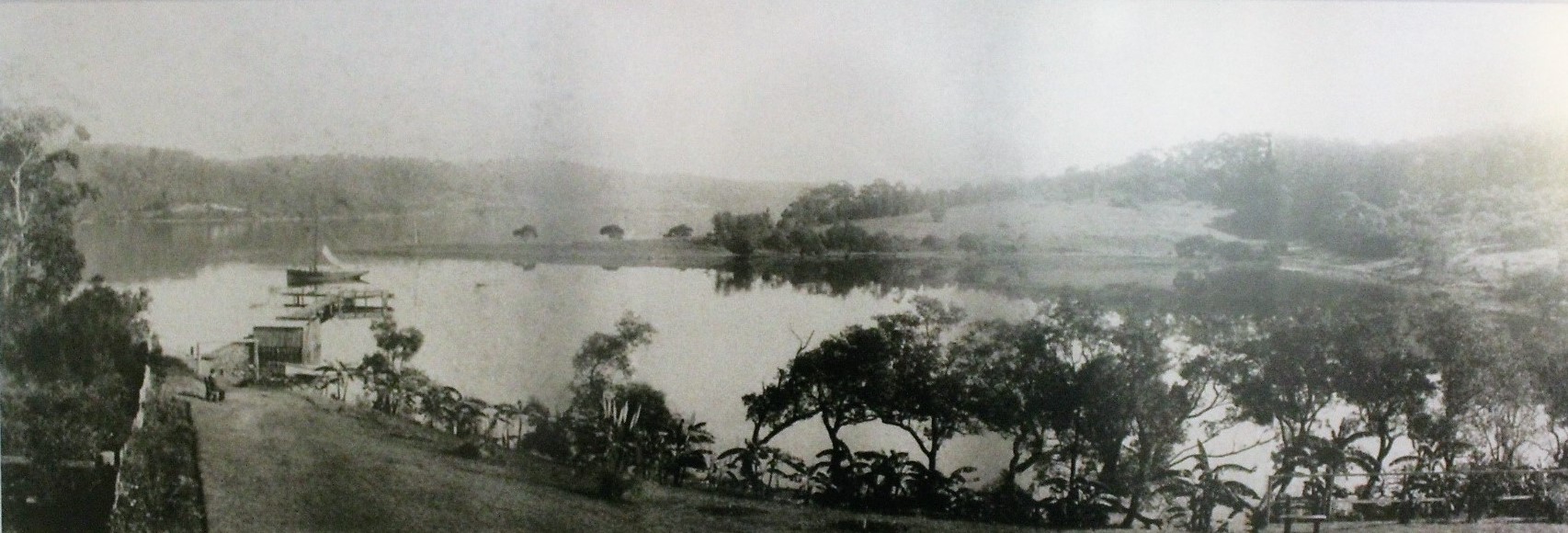
Green Point, circa 1890
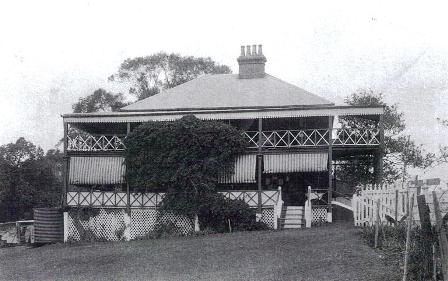
Black and white postcard of Scott's, circa 1900. Photo Courtesy of Pittwater Image Library, Mona Vale Library History Unit.
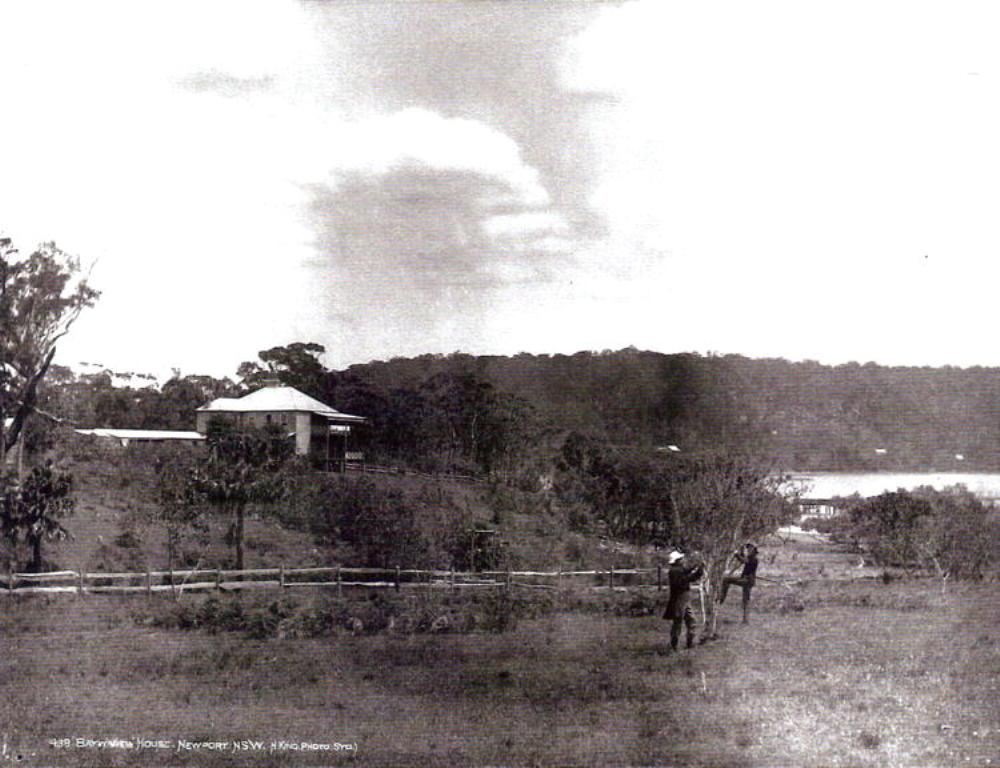
Henry King Photographs, courtesy National Library of Australia, NSW Records and Archives and Powerhouse Museum, c. 1887-1890. Top: Bay view House, Newport NSW. Below: Pittwater from Bay View House. All by Henry King.
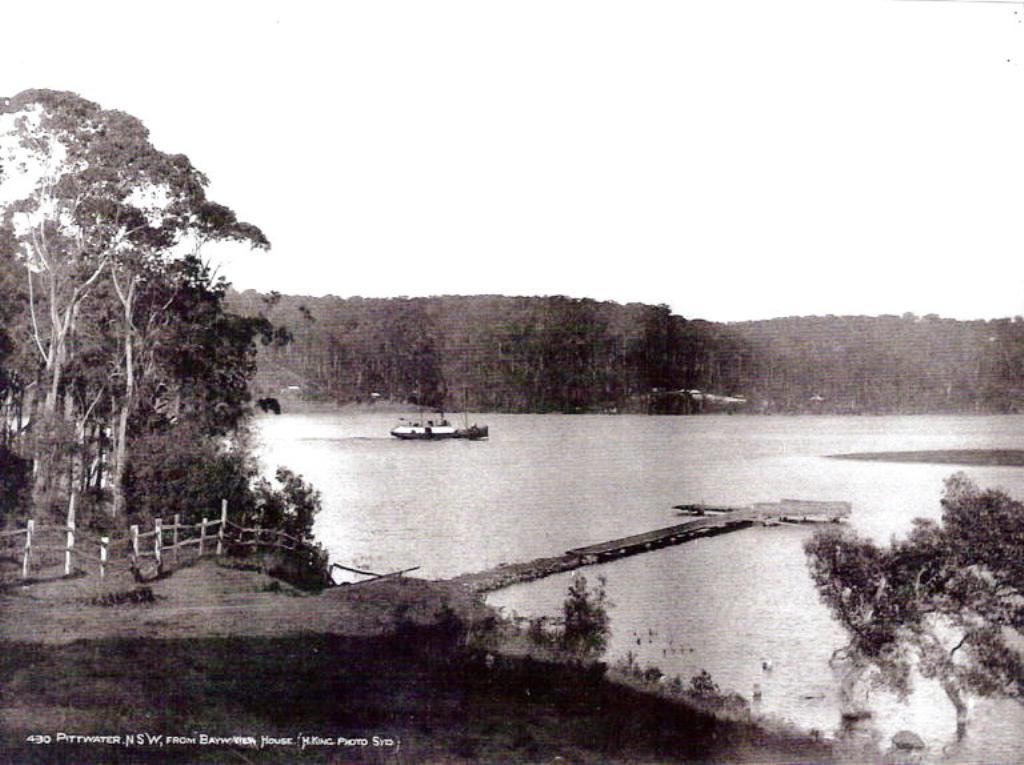


The steamer gong past Green Point is the Wyrallah, launched July 1887. See Boulton's Jetty, Newport Hotel Jetty and Newport Public Wharf history page (2024)

Bayview House from Loftus Point, Newport. circa 1880-1890 (Later named Green Point and site of present day RPAYC.)
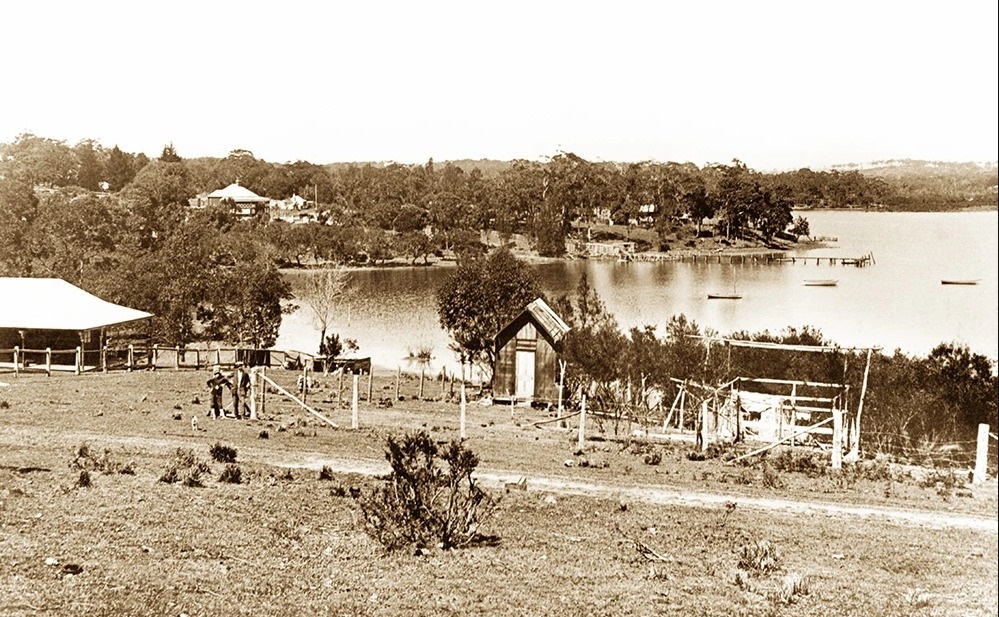
Crystal Bay circa 1925-1930, State Library of NSW photo

Newport from above circa 1946-1950 - a Frank Hurley photo
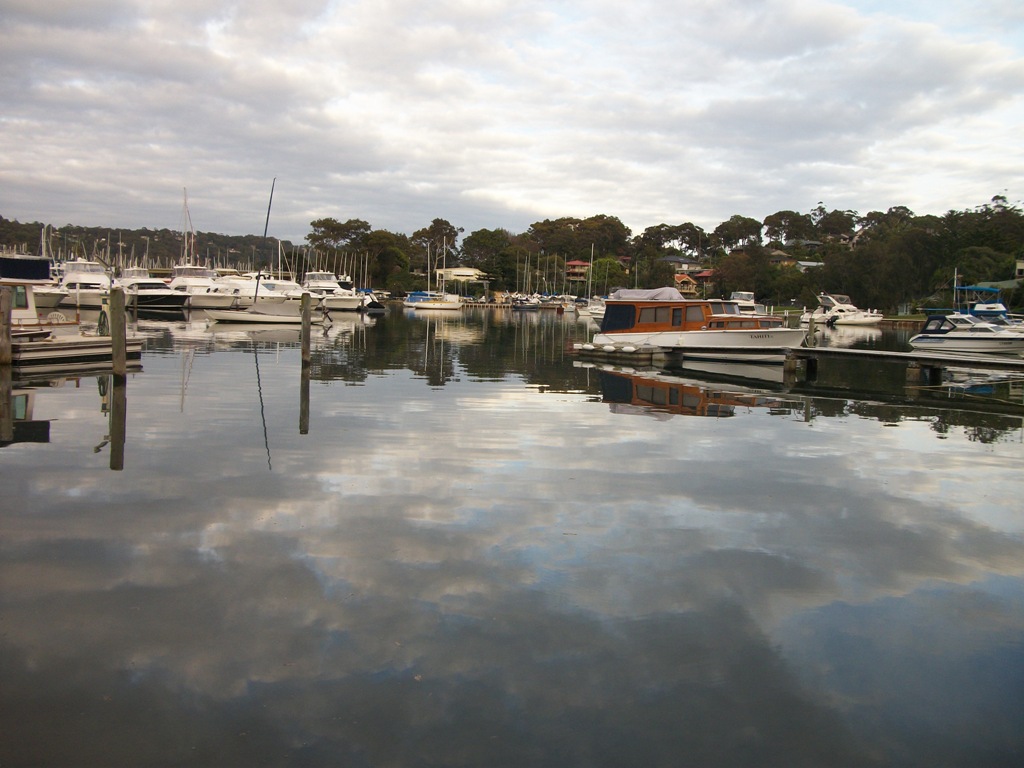
Crystal Bay December 2011. Above: Looking towards Green Point. Below: Looking from Green Point across Crystal Bay.
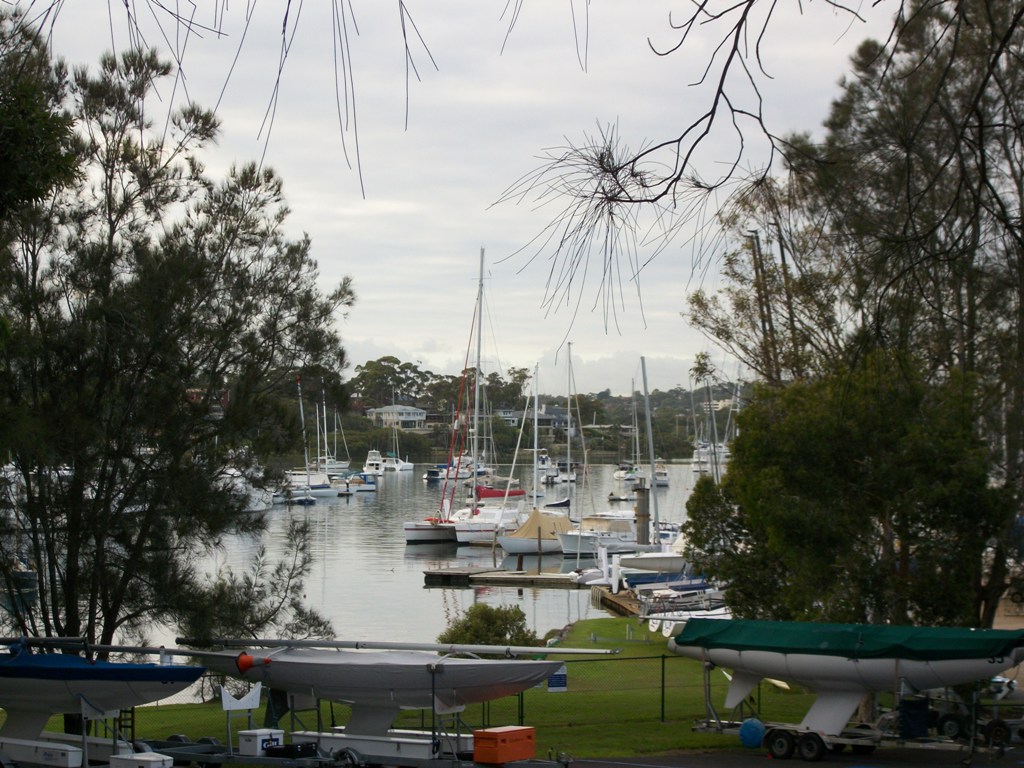

[Notice of Application for a Certificate of Discharge.]
In the Supreme Court of New South Wales.
IN BANKRUPTCY.
Re William Billiard, of Petersham, near Sydney, bookseller.
To the Official Assignee and Creditors.
HAKE NOTICE that the abovenamed William Bullard, intends to apply to His Honor the Judge in Bankruptcy, at the Court, Chancery-square, Sydney, on Friday, the 27th day of September, instant, at 11 a.m., or so soon afterwards as the course of business will admit, that a certificate of discharge be granted to him, under and according to the provisions of the Act SI Victoria Wo. 19.—Dated this 10th day of September, 1889.
ERNEST FARISH STEPHEN,
Solicitor for Bankrupt, 86, Pitt-street, Sydney. IN BANKRUPTCY. (1889, September 13). New South Wales Government Gazette (Sydney, NSW : 1832 - 1900), p. 6310. Retrieved from http://nla.gov.au/nla.news-article222098832
Collins retreat, Scotts Hotel and Bayview House - Threads collected by A J Guesdon, 2011.

